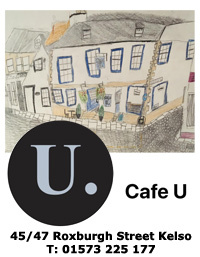We would like to thank the folks at Duncan House for their invaluable assistance in securing the ideal location for this camera and
Cafe U for sponsoring it. Additionally, we extend our appreciation to the Tweed Rivers Fisheries Association for their generous capital funding, which made the installation of this camera possible.The River Tweed at Kelso is renowned worldwide for its exceptional salmon fishing. Furthermore, the area boasts two esteemed eighteen-hole golf courses and a National Hunt (jumping) horse racing track, recognized as 'Britain's Friendliest Racecourse.' Kelso's racing tradition dates back to 1822. Situated at the confluence of the rivers Tweed and Teviot, Kelso is famous for the internationally acclaimed Junction Pool. Among the town's prominent attractions are the historic ruins of Kelso Abbey and the magnificent Floors Castle, a remarkable architectural masterpiece designed by William Adam and completed in 1726. The webcam provides a captivating glimpse of Floors Castle.The River Tweed, also known as Tweed Water (Abhainn Thuaidh in Scottish Gaelic), stretches across 97 miles primarily within the Borders region of Great Britain. Its source can be found at Tweedsmuir, near the origins of the Clyde, which flows northwest, and the Annan, which flows south. The Border saying, 'Annan, Tweed and Clyde rise oot the ae hillside,' beautifully captures the birth of these three rivers. The Tweed traverses the entirety of the Borders region, culminating near Berwick-upon-Tweed in its lower reaches.The town of Kelso owes its existence to the establishment of Kelso Abbey in 1128. Its name derives from the initial settlement's location on a chalky outcrop, known as Calkou or perhaps Calchfynydd during those early days. This historical fact is still commemorated today in the street name 'Chalkheugh Terrace.' Kelso and its neighboring hamlet, Wester Kelso, were connected to the vanished royal burgh of Roxburgh by a ferry located in Wester Kelso. While a small hamlet predated the abbey's completion, it experienced significant growth with the arrival of the monks, many of whom were skilled craftsmen. Their contributions supported the expansion of the village and aided the local population.Archaeological excavations conducted in the 1980s revealed that the original medieval burgh of Wester Kelso extended much farther west than previously believed. However, it was abandoned in the 14th or 15th centuries, likely due to the English occupation of Roxburgh Castle, which coincided with the desertion of the royal burgh of Roxburgh. Conversely, the settlement of Easter Kelso, situated near the abbey, endured and expanded from the market area around the abbey northwards towards the Floors estate by the early 18th century. It was during this period that 'Easter' Kelso ultimately became known as Kelso.Kelso Abbey held significant sway over the Kelso-area burgh of barony, known as Holydean, until the Reformation in the 16th century, after which its power and wealth diminished. The Kerr family of Cessford assumed control of the barony, acquiring many of the abbey's properties in and around the town. By the 17th century, the Kerr family effectively became the proprietors of Kelso.On Roxburgh Street, one can find the outline of a horseshoe petrosomatoglyph, marking the spot where Charles Edward Stuart's horse lost a shoe as he passed through the town on his way to Carlisle in 1745. Legend has it that he also planted a white rosebush in his host's garden, and it is believed that descendants of that rosebush still thrive in the area.For a period of time, the Kelso parish possessed the authority to levy a tax of 2 pence (2d) on every Scottish pint of ale, beer, or porter sold within the town. This power was extended for 21 years in 1802 under the Kelso Two Pennies Scots Act, with the funds dedicated to replacing a bridge across the River Tweed that had been destroyed by floods.Kelso Town Hall, a magnificent structure completed in 1816 and subsequently remodeled in 1908, stands as a testament to the town's rich heritage. The Corn Exchange, which now houses a health clinic, dental clinic, and an online publisher, was constructed in 1856. Moreover, the war memorial, designed by the esteemed Sir Robert Lorimer, was erected in 1921 as a poignant tribute to the fallen.







